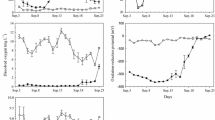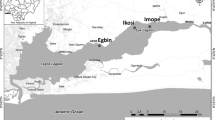Abstract
The heaviest algal bloom that can be expected in an aquatic system was formed in a waterchestnut ecosystem in Lake Kasumigaura during the summer in 1978 when the water temperature was greater than 30°C, caused by the nutrient discharges from the River Koise and the River Sanno. The heavy bloom not only threatens the steady-state equilibrium of the eutrophic system of the Lake but also must accelerate the Lake transformation into a low moor by forming ooze on the lake bottom with the precipitation of a large amount of dead blue-green algae.
Similar content being viewed by others
References
Azumagi, T.: 1929,Chirigakuhyoron 5, 157 (in Japanese).
Carr, N. G. and Whitton, B. A.: 1973,The Biology of Blue-green Algae. Blackwell Scientific Publications, Oxford, p. 676.
Department of Natural Resources: 1974, ‘Survey of Lake Rehabilitation Techniques and Experiences’, Technical Bull. No. 75, p. 179.
Fogg, G. E., Stewart, W. D. P., Fay, P., and Walsby, A. E.: 1973,The Blue-green Algae, Academic Press, London, p. 459.
Hattori, A. and Fujita, Y.: 1959,J. Biochem. 46, 633.
Knoechel, R. and Kalff, J.: 1975,Verh. Internat. Verin. Limnol. 19, 745.
Kuroiwa, K., Ogawa, Y., Seki, H., and Ichimura, S.: 1979,Water, Air, Soil, Pollut. 12,
Kusnezow, S. I.: 1959,Die Rolle der Mikroorganismen in Stoffkreislauf der Seen. Veb Deutscher Verlag der Wissenschaften, Berlin, p. 301.
Mitchell, R.: 1972,Water Pollution Microbiology, Wiley-Interscience, New York, p. 416.
National Academy of Sciences: 1969,Eutrophication: Causes, Consequences, Correctives, National Academy of Sciences, Washington, D.C., p. 661.
Sakurai, Y., Hayashi, I., Watanabe, Y., Amashiro, S., and Ohashi, T.: 1973, in ‘Report on Biological Investigation of Lake Kasumigaura’, Ministry of Construction, 78 (in Japanese).
Seki, H., Ogura, N., Yamaguchi, Y., Murakami, A., Kitamori, R., and Tsuji, T.: 1975, in ‘The Present Status of Investigations Related to Pollution in the Marine Environment,Oceanog. Soc. Japan 1 (in Japanese).
Seki, H., Takahashi, M., Hara, Y., and Ichimura, S.: 1979,Water Res.
Strickland, J. D. H. and Parsons, T. R.: 1968,A Practical Handbook of Seawater Analysis, 2nd edition, Bull. Fish. Res. Bd. Canada 167, p. 311.
The National Institute of Environmental Studies: 1979, Occasional publication R-6-'79. p. 420.
Tsuchiya, T., and Iwaki, H.: 1980,Water, Air, Soil, Pollut.
Yoshimura, S.: 1937,Limnology, Sansho-do, Tokyo, p. 426 (in Japanese).
Welch, P. S.: 1952,Limnology, McGraw-Hill Book Company, Inc., New York, p. 538.
Wetzel, R. G.: 1966,Invest. Indiana Lakes Streams 7, 147.
Author information
Authors and Affiliations
Rights and permissions
About this article
Cite this article
Seki, H., Takahashi, M. & Ichimura, SE. Impact of nutrient enrichment in a waterchestnut ecosystem at Takahama-Iri Bay of Lake Kasumigaura, Japan. Water Air Soil Pollut 12, 383–391 (1979). https://doi.org/10.1007/BF01047024
Received:
Revised:
Issue Date:
DOI: https://doi.org/10.1007/BF01047024




